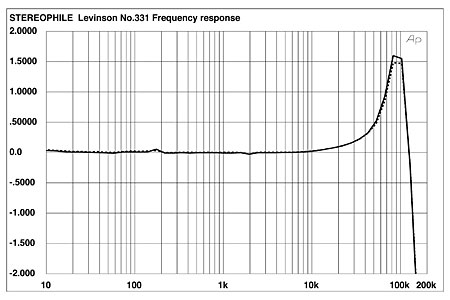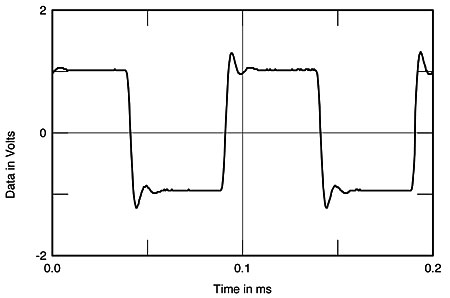| Columns Retired Columns & Blogs |
Mark Levinson No.331 power amplifier Measurements
Measurements
A full set of measurements of the Mark Levinson No.331 was made in its unbalanced mode, though many readings were repeated in the balanced configuration and will be referenced as appropriate below.
Following the 1/3-power, one-hour preconditioning test, the No.331's heatsinks were no more than warm to the touch. The No.331 is noninverting in the unbalanced mode; in the balanced mode, pin 2 is wired as positive. Its input impedance measured 49.3k ohms (112.7k ohms balanced). The output impedance was below 0.02 ohms at 1kHz, 20Hz, or 20kHz, and should not in any way affect the system's frequency response into different loudspeaker loads. Voltage gain into an 8 ohm load measured 26.7dB, balanced or unbalanced. S/N ratio (ref. 1W into 8 ohms) measured 77dB over a 22Hz–22kHz bandwidth, unweighted, 79.4dB A-weighted. Over a wider 0Hz–500kHz bandwidth, still referenced to 1kHz into 8 ohms, it measured a surprisingly poor 61.6dB unweighted.
Fig.1 shows the frequency response of the No.331 at 1W into 8 ohms; the results into 2 ohms, 4 ohms, and a simulated load, either balanced or unbalanced, were virtually identical. Note the ultrasonic peak, around 1.5dB high just below 100kHz. It's not strong enough to be of any concern in the audible performance of the amplifier, but it is rather unusual. It also shows up in the 10kHz squarewave response (fig.2) as a well-damped overshoot with a single cycle of ringing. It was also seen in the 1kHz squarewave (not shown).

Fig.1 Mark Levinson No.331, unbalanced mode, frequency response at 1W into 8 ohms (right channel dashed, 0.5dB/vertical div.).

Fig.2 Mark Levinson No.331, small-signal 10kHz squarewave into 8 ohms.
Fig.3 shows the No.331's channel separation. This is an excellent result; the balanced crosstalk is marginally better than the unbalanced, but the difference is insignificant.

Fig.3 Mark Levinson No.331, crosstalk (from top to bottom at 400Hz): L–R, R–L, unbalanced; L–R, R–L, balanced (10dB/vertical div.).
The manner in which the '331's THD+noise level varies with frequency and load impedance is shown in fig.4. The result appears to be largely dominated by noise below about 3kHz. The waveform of the distortion is shown in fig.5: it's heavily second-harmonic, with noise, plus some higher order components. The spectrum of the No.331's output while it was driving a 50Hz input at high power into a simulated real load is shown in fig.6. The only artifact greater than –80dB (0.01%) is at 150Hz (–76dB, or about 0.015%). Into a pure 4 ohm load at the same power output (134W, not shown), the artifacts were all under –80dB (the 150Hz artifact dropping to nearly –100dB, or 0.001%).

Fig.4 Mark Levinson No.331, THD+noise vs frequency at (from top to bottom at 15kHz): 4W into 2 ohms, 2W into 4 ohms, 2.83V into simulated speaker load, and 1W into 8 ohms (right channel dashed).

Fig.5 Mark Levinson No.331, 1kHz waveform at 5W into 2 ohms (top); distortion and noise waveform with fundamental notched out (bottom, not to scale).

Fig.6 Mark Levinson No.331, spectrum of 50Hz sinewave, DC–1kHz, at 134W into simulated speaker load (linear frequency scale). Note that the third harmonic at 150Hz is the highest in level, at –76dB (about 0.015%).
Fig.7 shows the amplifier's output spectrum reproducing a combined 19+20kHz signal at a power level of 118W into 4 ohms. This is also a superb result, with only the 18kHz and 21kHz intermodulation products (at –70dB or 0.03%) exceeding –80dB. At 63W into 8 ohms (not shown) the results were very similar. The 1kHz, THD+noise vs output power curves for the No.331 are shown in fig.8. Comfortably exceeding its rated power specification, it behaves close to a voltage source, with the power almost doubling when the load impedance halves. The discrete clipping levels are shown in Table 1.

Fig.7 Mark Levinson No.331, HF intermodulation spectrum, DC–22kHz, 19+20kHz at 118W into 4 ohms (linear frequency scale).

Fig.8 Mark Levinson No.331, distortion (%) vs output power into (from bottom to top at 10W): 8 ohms, 4 ohms, and 2 ohms.
Table 1: Mark Levinson No.331 Discrete Clipping levels (1% THD+noise at 1kHz)
| Impedance | Both Channels Driven | One Channel Driven | |
| Load | W (dBW) | W (dBW) | W (dBW) |
| ohms | L | R | L |
| 8 | 134.4 (21.3) | 135.3 (21.3) | 134.5 (21.3) |
| Line voltage | 118V | 118V | 118V |
| 4 | 254.3 (21.1) | 254.7 (21.1) | 254.1 (21.1) |
| Line voltage | 117V | 117V | 117V |
| 2 | 453.6 (20.6) | ||
| Line voltage | 117V | ||
With the exception of the lower-than-expected S/N measurements—which were apparently not a factor in the listening tests—this is a superb set of test-bench results.—Thomas J. Norton
- Log in or register to post comments




































